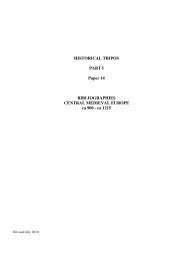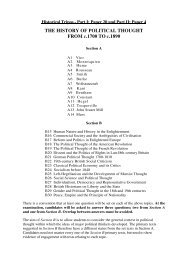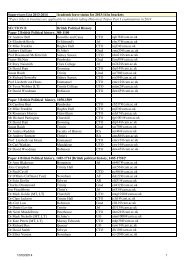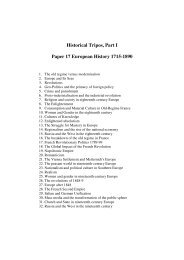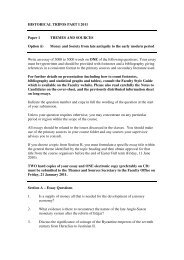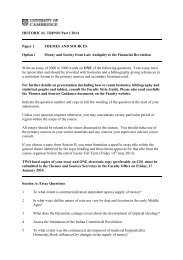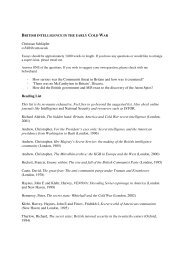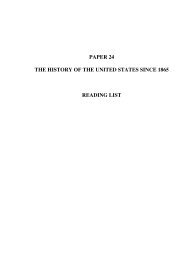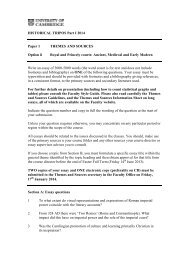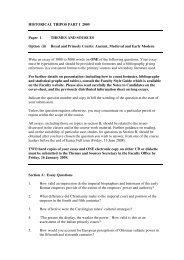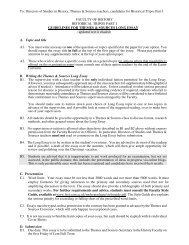Course Handbook - Faculty of History - University of Cambridge
Course Handbook - Faculty of History - University of Cambridge
Course Handbook - Faculty of History - University of Cambridge
You also want an ePaper? Increase the reach of your titles
YUMPU automatically turns print PDFs into web optimized ePapers that Google loves.
esearchers, you must acknowledge their contribution fully in your introductory section.<br />
If there is likely to be any doubt as to who contributed which parts <strong>of</strong> the work, you<br />
should make this clear in the text wherever necessary, e.g. 'I am grateful to A. Smith for<br />
analysing the sodium content <strong>of</strong> these samples';<br />
• be especially careful if cutting and pasting work from electronic media; do not fail to<br />
attribute the work to its source. If authorship <strong>of</strong> the electronic source is not given, ask<br />
yourself whether it is worth copying.<br />
3 The Golden Rule:<br />
The examiners must be in no doubt as to which parts <strong>of</strong> your work are your own original work<br />
and which are the rightful property <strong>of</strong> someone else.<br />
THE TYPESCRIPT<br />
The following notes give guidance on the preparation <strong>of</strong> a typescript, on bibliographies and footnoting. They<br />
are not intended to be exhaustive, nor are they compulsory. There are a number <strong>of</strong> accepted conventions that<br />
you can use. The conventions outlined below have been adapted from the house-style <strong>of</strong> the <strong>Cambridge</strong><br />
Historical Journal. Recent articles published in this journal will normally provide a good model for you to<br />
follow, in line with the guidance outlined here. You may, however, wish to chose a different set <strong>of</strong><br />
conventions. The main principle is to be consistent. Choose your system and stick to it. If you have doubts<br />
about using the system outlined below, seek the advice <strong>of</strong> your Supervisor. For another helpful source <strong>of</strong><br />
very detailed guidance on all aspects <strong>of</strong> bibliographical style and other conventions such as abbreviations,<br />
spelling, capitalization, etc., consult the style guide <strong>of</strong> the MHRA (Modern Humanities Research<br />
Association), available as a pdf file at:<br />
http://mhra.org.uk/Publications/Books/StyleGuide/download.shtml<br />
Always make regular backups <strong>of</strong> your computer files, as well as hard copy print-outs.<br />
Have your dissertation printed on one side <strong>of</strong> A4 paper (on a laser printer or a good inkjet printer). You may<br />
wish to make use <strong>of</strong> the laser printing facilities provided in the <strong>Faculty</strong>’s Graduate Research Room.<br />
Leave margins <strong>of</strong> at least 40mm at the top, the left and the foot, and 25mm at the right.<br />
Everything in the main text should be one-and-a-half spaced, except indented quotations and footnotes<br />
(which should be at the foot <strong>of</strong> the page) which should be single-spaced. Be sure to paginate.<br />
There is no prescribed typeface but it is strongly recommended that candidates use simple classical typefaces<br />
(such as Times Roman). Use 12 pt for the body <strong>of</strong> the text and 11 pt for footnotes.<br />
Many word-processing programmes are capable <strong>of</strong> producing accents and non-roman characters, as well as<br />
printing mathematical symbols and equations. Candidates are advised to use such word-processing packages<br />
but in the case <strong>of</strong> rare languages the appropriate fonts may not be available, in which case hand-written<br />
additions to the typed texts are allowed. See that any handwriting is entirely legible, and that subscripts and<br />
superscripts are clearly positioned.<br />
Paragraph breaks should be indicated by indents and not line breaks. The first paragraph <strong>of</strong> an article, and <strong>of</strong><br />
numbered sub-sections, should not be indented.<br />
TEXT CONVENTIONS<br />
Headings<br />
Do not use more than three kinds <strong>of</strong> headings within a chapter; the more kinds there are, the more difficult it<br />
will be for the reader to distinguish one grade from another.<br />
Abbreviations.<br />
A list <strong>of</strong> abbreviations used in the text and the footnotes should be placed at the beginning <strong>of</strong> the thesis, after<br />
the preface.<br />
Tables<br />
28




